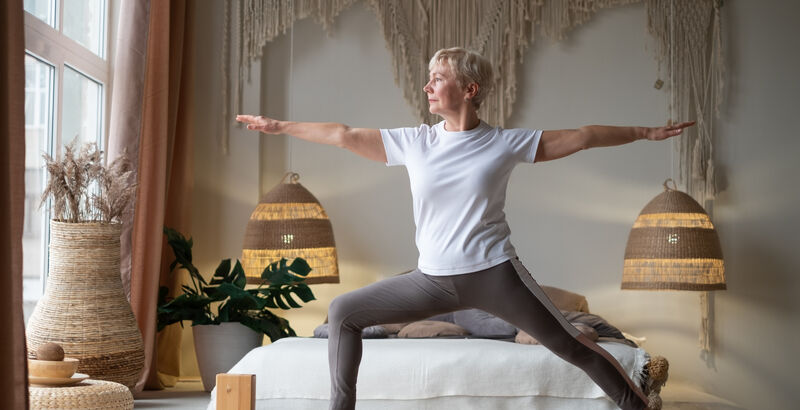
11 Yoga Poses for Incontinence
Getty/Koldunova_Anna
Experiencing urinary leakage or an overactive bladder? Consider adding any of these yoga poses to your practice to encourage pelvic floor strength.
According to the National Association for Continence, approximately 25 million American adults deal with urinary incontinence, up to 80 percent of whom are women.
According to Mayo Clinic, “Urinary incontinence—the loss of bladder control—is a common and often embarrassing problem. The severity ranges from occasionally leaking urine when you cough or sneeze to having an urge to urinate that's so sudden and strong you don't get to a toilet in time.”
The overactive bladder is more common in older people—speaking Ayurvedically, those in the Vata stage of life—especially women. When you think of life events that are unique to women—pregnancy, childbirth, repeated urinary tract infections, or even menopause—you can see the correlation. Almost half of all women over the age of 50 experience incontinence.
What Causes Incontinence?
UI is caused by the muscles that help bladder control or pass urine. A decrease in the strength of muscles of the sphincters and pelvis or overuse of the muscles can also cause it. It’s easy to assume that urinary incontinence is an inevitable consequence of aging. But research will tell you that a person can leak urine for other reasons as well: stress, medications, inflammation or irritation of the bladder and urinary tract, extreme anxiety, intense laughter, coughing, sneezing, lack of access to bathroom, postural issues (change in posture can lead to incontinence), or even fighting the urge to urinate.
Urinary incontinence can become an obstacle in day-to-day life. It induces stress and creates uncomfortable situations. It also lowers self-esteem and hampers sexual functions in both men and women.
How Yoga Can Help Navigate Urinary Incontinence
Yoga practice helps to strengthen the pelvic floor muscles and the hips. It also increases stability and mobility while reducing stress and pelvic pain.
According to a study done by UC San Francisco, yoga poses can help strengthen your pelvic floor and gain control of involuntary urinary leakage. When performed daily, specific yoga poses that engage the lower back and abdominal region may effectively combat urinary incontinence and restore normal excretory functions. They can help pelvic muscles regain strength, which in turn helps them to better maintain urine flow and resist excessive force put on the bladder.
That said, the yoga poses are not to be considered a replacement for medical advice. Kindly get guidance from a family doctor, yoga therapist, or a qualified yoga teacher before beginning the practice of any yoga asanas.
Yoga Poses for Incontinence
Not all types of yoga may help with urinary incontinence. But there are yoga postures that not only improve mindfulness, relaxation, and balance but also provide a great support to the pelvic floor. A few even help your digestive system. These are poses that improve pelvic health and may reduce bladder leaks. But depending on your existing health condition, as well as age, a few asanas might work better than the others.
Tadasana (Mountain Pose)
Utkatasana (Chair Pose)
Trikonasana (Triangle Pose)
Virabhadrasana (Warrior 2)
Malasana (Squat Pose)
Paschimottanasana (Seated Forward Bend)
Setu Bandha Sarvangasana (Supported Bridge Pose)
Supta Baddha Konasana (Reclining Bound Angle Pose)
Viparita Karani Variation (Legs Up the Wall Pose)
Apanasana (Knee to Chest)
Savasana (Corpse Pose)
Disclaimer: The content is purely informative and educational in nature and should not be construed as medical advice. The information is not intended for use in the diagnosis, treatment, cure, or prevention of any disease. The yoga poses are not to be considered a replacement for medical advice. Please use the content only in consultation with an appropriate certified medical or healthcare professional. Please consult a medical professional and/or a licensed yoga teacher or yoga therapist before starting any exercise regime, including yoga. If you are looking for advice from a trained yogi and Ayurvedic coach, contact Sweta here.










